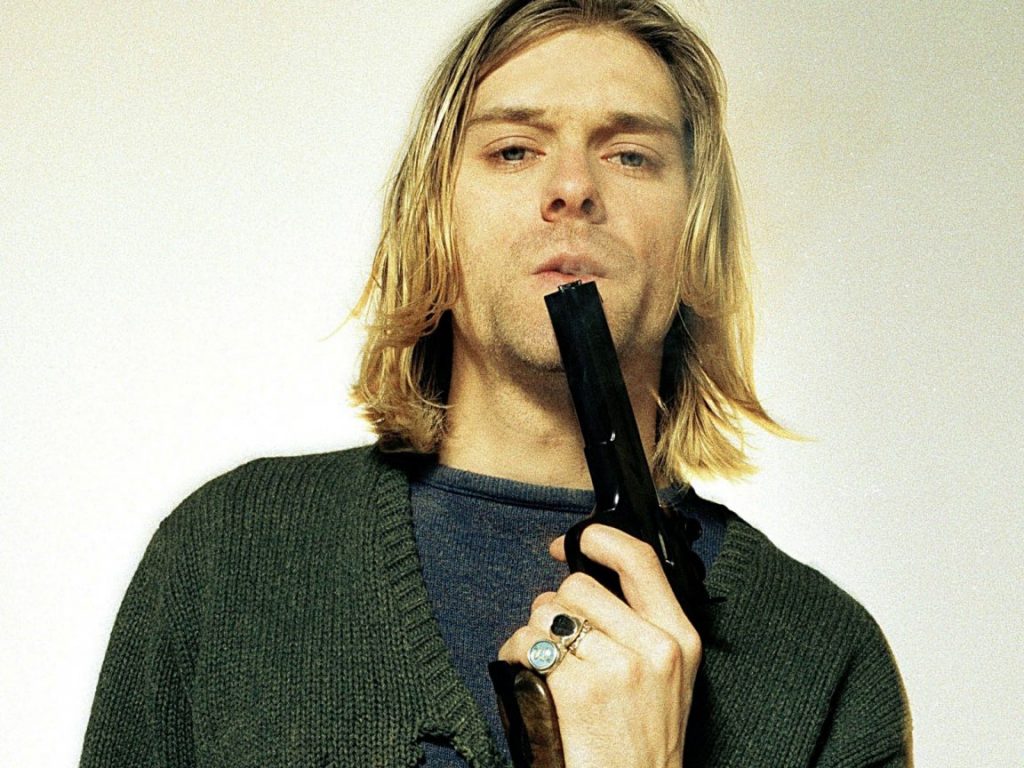“I’m not afraid of dying. Total peace after death, becoming someone else is the best hope I’ve got.” This statement made by Nirvana front-man Kurt Cobain reflects both the self-loathing and general sorrow, or anguish, that he felt he was constantly suffering from and ultimately what led to the tragic event that occurred on April 5, 1994. Kurt Cobain, the lead singer of the band Nirvana, was born in Hoaquiam, Washington on February 20, 1967.1 Few honestly know of the struggles Kurt had to endure in his life, such as his parents’ divorce when he was about nine. This break-up resulted in Kurt losing a permanent place of residence, leaving him in a constant state of borderline homelessness. As a matter of fact, Kurt even resorted to staying at the hospital where he was born around the age of nineteen.2 Regardless, Kurt still managed to climb from rock bottom to become the star he was: the lead singer of Nirvana and the face of grunge music for many people worldwide.

Of course, Nirvana didn’t come straight out the gate making hits nor score international shows. The band Nirvana actually had quite a macabre or fuzzy rise in comparison to other bands. Interestingly enough, Nirvana didn’t even start off being called Nirvana. This small trio actually bounced around with abstract names for quite a few years. From their humble beginnings in Aberdeen, Washington, in 1987 the band was known as Skid Row, Pen Cap Chew, and Bliss all within the same year.3 They played a few house parties and even fewer shows at real venues around the Aberdeen area, but the band life was more of a hobby to the group. They had fun doing what they did, played their hearts out when they had to, but they didn’t really think they were going to be anything huge when they first started out.
The group may have started small, but the effort and time they put into the band would soon enough pay off. In 1989, they released their independent album Bleach, which got them a lot more shows in lots of new places. The band finally started “blowing up” and gathering many followers nationwide. With this newfound momentum, Nirvana signed with Geffen Records and released their second album Nevermind, which has since become legendary. This was just two years after their first independent album Bleach was released.4 Nevermind kicked off Nirvana’s international rise to a new high, scoring them not only shows around the country, but in other countries as well. Nirvana went global and this new, dissonant, and muddy type of rock music started receiving mainstream recognition. This new and quickly popular genre became known and recognized as grunge, a form of punk rock with the muddy sounds of post-punk mixed with a sprinkle of youthful angst.5 This new genre became the sound of the ’90’s, with many bands such as Soundgarden, Pearl Jam, and Alice in Chains riding the wave. But for many worldwide, songs such as “Smells Like Teen Spirit” or most of the songs from Nirvana’s Nevermind album became grunge anthems that depicted the youthful rebellion and dissonance reflected in grunge music.6

Although Nirvana was finally blowing up and rising to international fame quickly, the lead singer Kurt Cobain was still not truly satisfied with his life. Throughout his life, Cobain constantly suffered from stomach illnesses. In response to this constant illness, Kobain would abuse drugs like heroin, claiming it would cure this problem. Even worse, when Kurt met his soon to be mother of his child Kourtney Love, his heroin abuse only got worse.7 With more money and fame, his addiction grew stronger and the pressures of fame and fortune began mounting on his shoulders, until one day it was just too much. In 1994, while on tour in Europe, Kurt had to be hospitalized for drug overdose and other health issues including alcohol problems. Soon after, he was forced to cancel the tour and return back home to Seattle. His family and friends decided to stage an intervention and convince him to admit himself into rehab, much to his displeasure. This rehabilitation did not last long, as Kurt decided to flee the rehab center and return back home to Seattle, tragically unbeknownst to his family and friends. On April 8, 1994, an electrician found Kurt Cobain’s dead body in a room above the garage above his home where he was hiding out at.8 The cause of death was a self-inflicted shotgun blast to the head, and even worse, heroin was found in his system so it’s not even clear if Cobain really meant to do that to himself or if the drugs influenced him to do so.9
Cobain’s inconceivable and unanticipated death resulted in worldwide mourning over the loss of this young artist’s life. Family and friends, especially his girlfriend and daughter, were heavily affected by this tragedy, as well as all of his listeners. Cobain was an icon for Generation X. He gave voice to the youthful generation of people that felt they were dealt a bad hand. He encouraged the generation, and became “the poster boy for grunge.” After Kurt’s death, the grunge scene died down quickly. Of course, there were still other bands in the genre putting out a few successful albums, but the genre never saw the fame and glory it had during its heyday in the early ’90’s, when Nirvana was contributing to the movement.10 The genre died out as quickly as it was born, with the untimely and very unfortunate death of a very talented and tormented young artist.
- Salem Press Biographical Encyclopedia, 2013, s.v. “Kurt Cobain,” by Delbert S. Bowers. ↵
- Nick Soulsby, I Found My Friends: The Oral History of Nirvana (New York : Thomas Dunne Books/St. Martin’s Griffin, 2015). 7. ↵
- Salem Press Encyclopedia, 2013, s.v. “Nirvana (music),” by Alan Haslam; Nick Soulsby, I Found My Friends: The Oral History of Nirvana (New York : Thomas Dunne Books/St. Martin’s Griffin, 2015), 1-18. ↵
- Salem Press Encyclopedia, 2013, s.v. “Nirvana (music),” by Alan Haslam. ↵
- Baker’s Biographical Dictionary of Popular Musicians, 2004, s.v. “Grunge: A Brief History of a Hard Rock Genre,” by Gil Kaufman. ↵
- Baker’s Biographical Dictionary of Popular Musicians, 2004, s.v. “Grunge: A Brief History of a Hard Rock Genre,” by Gil Kaufman. ↵
- Salem Press Biographical Encyclopedia, 2013, s.v. “Kurt Cobain,” by Delbert S. Bowers. ↵
- Salem Press Biographical Encyclopedia, 2013, s.v. “Kurt Cobain,” by Delbert S. Bowers. ↵
- Salem Press Encyclopedia, 2013, s.v. “Nirvana (music),” by Alan Haslam. ↵
- Baker’s Biographical Dictionary of Popular Musicians, 2004, s.v. “Grunge: A Brief History of a Hard Rock Genre,” by Gil Kaufman. ↵



112 comments
Alexandra Lopez
I have always been a fan of Nirvana because my mom in her younger years was into the grunge rock and she let me listen to her music when I was the appropriate age. This article was well written and captured the readers with the influence Kurt Cobain has left. It is a tragedy that such a young talented man left this world too soon, but his legacy will live on.
Diego Aguilera
Never really been a fan of Nirvana’s music but i knew who Kirk Cobain was and in fact my parents were big fans. To see somewhere start from the bottom and rise to fame is a great site and in fact gives hope to anyone looking for answers and wanting more for themselves. But in Cobain’s case he let drugs get the best of him and the actions he decided to take showed the affect. Its sad but he is still very influential and in fact his life story is one to be shared and remembered for generations to come.
Daniel Linstead
Kurt Cobain, a very talented individual that was taken too early. Like many music artists struggled with drug addiction. It makes you wonder that with all the drug addiction that goes on in the music industry that there is a connection between the industry and drugs. Is been a music artist as easy as we all thought or does it actually ruin people and bring them to rock bottom. Good article to read, I enjoyed reading about a band I enjoy listening to on the odd occasion.
Jabnel Ibarra
Suicide is, statistically, the leading cause of preventable death in the United States. Its tragic to imagine what Kurt Cobain must have been going through in the final days of his life, even more so to imagine that he might still be alive today if someone close to him recognized that he was in pain and reached out a helping hand to him. Reading this article and the many comments above, I believe it is important to remember him not for the loss of his talent, but for the loss of a life. Behind the guitarist, the singer, the face of Nirvana, was a person.
Diego Aguilera
Never really been a fan of Nirvana’s music but i knew who Kirk Cobain was and in fact my parents were big fans. To see somewhere start from the bottom and rise to fame is a great site and in fact gives hope to anyone looking for answers and wanting more for themselves. But in Cobain’s case he let drugs get the best of him and the actions he decided to take showed the affect. Its sad but he is still very influential and in fact his life story is one to be shared and remembered for generations to come. Drug addiction is no joke and should be taken way more serious as we keep losing artist we care about.
Eloisa Sanchez Urrea
This article goes to show that money and fame is not enough to give someone’s life meaning and purpose. Kurt Cobain had a very troubled childhood, and still he managed to reach more success than he may ever have imagined. Instead of taking pride in his triumph he felt inadequate and reliant on drugs. His story had a very tragic ending that I did not imagine at all.
Julia Deais
Kurt Cobain was very well-known in the music industry and it’s sad to see such young artists pass due to drug addiction. This goes to show that the pressure of succeeding that is put on musicians in the industry is impossible to achieve. The divorce of his parents definitely impacted his drug addiction because he had an unstable childhood and never had a permanent home. He also never stopped to enjoy his achievements, he was always trying to achieve more, so thats why he thought the drugs helped him, when in reality, it was making it worse.
Pamela Callahan
I’ve heard of the band Nirvana, but I didn’t know anything about the lead singer, Kurt Cobain. Reading his story and hearing about the struggles he endured throughout his life made me realize how hard it must be to live up to the pressure of constantly being under the spotlight. This article was very well written and the featured image used at the beginning was very powerful.
Brianna Ford
This was a very good article, I really did not know who Kurt Cobain was, or the band in general. I did not know they were very popular during their time. Kurt and his band influenced young individuals and it was unfortunate that Kurt was going through so much with having everything, which shows that mental illness is a real thing. It is also unfortunate that after his death, Nirvana faded away, which also shows he was the heart and the soul of the band. I am sure that Kurt Cobain will always be known for what he did and the impact he had on his fans from all over the world.
Marina Castro
Nirvana is a very well-known band that has only grown more in popularity in the past years. Many people listen to them without knowing the story behind their members. Their music really expresses the hardship they had to endure. It’s sad to know that Kurt Cobain never found peace. Many say that Nirvana died with him, but their music will always be immortalized.